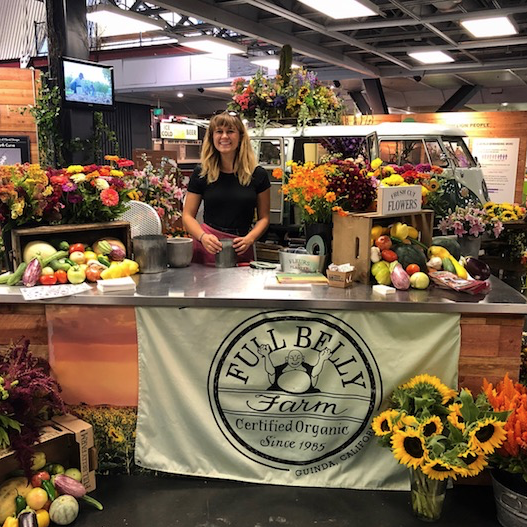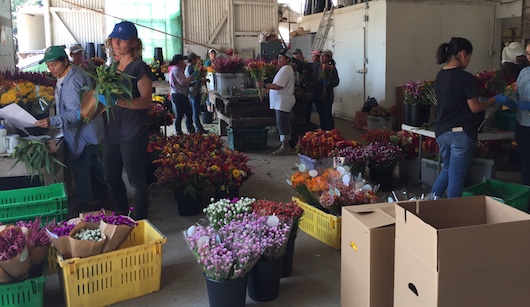
Hannah at the California State Fair.
It is Monday morning and the skies here are thick with the smoke and haze from the many fires burning in Northern California. We told our farm crew that if it is difficult to work, we may end the day early. We had shortened days this past week when field temperatures were near 112º. The sobering relationship of too little rain, a parched landscape, high temperatures, heavy fuel loads in areas where homes are being built under tree canopies, make one reflect about resilience, climate uncertainty, and our relationship with our larger landscape and wild lands.
At the farm, just a short two weeks ago, our brush with fire ended with few structures lost on near 100,000 acres burned. Our hearts go out to those in the Redding area who are facing catastrophic losses as the Carr fire rages. We live in an interconnected world. Addressing these tragedies may require us to rethink our patterns of tenureship, solving for a management pattern that links us to the work of tending our landscapes more intimately by understanding and investing in their health.
Here are some of my thoughts on biodiversity, one of the fundamental tenets underlying the approach that many organic farmers take in the design of their farms. In biodiverse ecologies we find:
Serendipity
Complexity
Refractive parts
Healthy interconnections
The whole greater than the sum of the parts
More layers
Systems as ecosystem of individual ecosystems
Like many of the cornerstone organic principles that are being validated over the long term, biodiversity expands the dimensions and complexity of a farm. By designing broadly for soil fertility, plant diversity, and plant and animal health, or by creating environments that support beneficial insect life like honeybees and other pollinator populations, diverse farm design can foster more total life per square foot of farm. Farm design, for example, can support the good warrior insects like lacewings, praying mantis, big eye bugs, and spiders, who in turn support crop health by fighting insects that damage our crops from time to time — it may be “build it and they will come.”
A definition of a healthy ecological system that is by design more stable and sound, should mimic a climax ecology — layers of life, a closed loop of nutrient cycling and the maximum harvest of sunlight through growing plants and microbial populations. These ecological systems maximize the utilization and retention of water, while fostering complex populations of soil microbial life – yeasts, fungi, bacteria, nematodes, algae, and protozoa, along with the soil animals like earthworms, springtails, and beetles – billions per teaspoon, trillions per acre.
Farms generally manipulate an environment to produce a crop. The current agribusiness model in doing so has become almost entirely focused on yield – the more the better. Little attention is paid to the efficiency and complexity of climax systems as a model for the design of farms. Our agricultural knowledge evolved with a plow, oxen, acres (measured and defined as the area in furlongs that an oxen could plow in a day), and the breaking apart of nature in order to understand it.
We evolved the body of knowledge about plants, plant foods, weeds, insects, crop selection, and crop science through a selection of tools like fertilizers that produced easily verifiable results — greener plants, faster growth, or herbicides that eliminated the need to laboriously chop or pull the weeds that might compete with a crop, or the plant breeding lines that responded best to a package of these tools. The results reinforced the selection of more of the same type of technologies. It was like climbing a ladder. Each rung is a logical step to continue upward, in the same direction, along the same logical pathway, even if it is a bit more precarious. From that line of thinking, it has become so difficult to take another tack without going down and starting with a whole new set of assumptions.
The design of a farm that incorporates biodiversity into its structure offers a chance to see things that one might not see in a heavily controlled and single crop farm field. When field edges are populated with flowers (some planted and some weeds) we find a myriad of insects moving into the fields and going to work for us. When orchards have an understory of grasses, plantain, clovers and other plants, that diverse ecology allows for soil to continue to form through the root systems and the life resulting from the harvest of sunlight and carbon – pulled through a living plant and moved into the soil through the roots as the food for all life in the soil.
Those edges and understories of plants give us pollen and nectar for pollinating insects that help pollinate our crops. We see ladybeetles that like our grasses on the edge before they move out to feast on any aphids that might provide them food. We find spiders there in dry grasses that spin their nets. Our orchards grow food – pollen and nectar – for bee populations long after the trees have bloomed. They prosper there in the managed design of clovers and flowering plants growing under the trees.
The edges and understories slow down water, allowing it to penetrate the soil, following root systems and earthworm tunnels deeper in the earth where it becomes available for plants through the season. The carbon that is pulled in through those living plants becomes the key for soil regeneration, made more efficient by a diversity of roots and species that cover and themselves are part of a system of life below the soil, each plant its own unique factory for the harvest of sunlight and the exuding of its unique food through its roots to feed soil life.
We live in an active relationship with these systems whose potential outcomes are inherent in the design and awareness of the farmer. The eye of the farmer has been focused on yield rather than yield with diversity. Enriching the system with more complexity creates a larger whole where more is gained biologically, enhancing the farm’s bottom line.
Today, the eye of the farmer sees weedless, bare ground orchards as an expression of good farming practice. They see edges with weeds as a place to harbor potential problem insects that may affect the crop. Landlords who control the acreage rented to farmers demand clean fields and weedless, treeless edges. Perhaps the eye needs to see beauty differently and appreciate diversity in some of its messiness, allowing spaces for the serendipity of complex living systems to reveal themselves.
Enhancing the system with diversity requires stepping back and examining potential that the farm can harvest with the cycle of sunlight, plant diversity, carbon capture, soil life, insect life, or water infiltration and the effective water harvested and utilized through the year- rather than just applied to crops. The whole becomes greater than the sum of the parts.
We may be at a time when a rethinking of our relationship to place is necessarily changing. Wild lands may need occasional burning to lower fuel load, best done in the spring when fire can be controlled. Investment in preventative patterns may be more cost effective than the expense of resources needed to fight an inferno. Understanding how we might harvest more water in place, to be infiltrated and absorbed into the soil to keep things greener, requires a rethinking of natures potential. Our need to be active in the resilience of this planet will require new thinking and new patterns of investment. There are warnings in the flames and at the same time opportunities to steward our future.
—Paul Muller

Many hands are needed to make the amazing flower bouquets each day.
